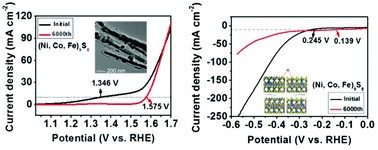A bifunctional electrode engineered by sulfur vacancies for efficient electrocatalysis†
Abstract
Defect engineering is an efficient method to enhance electrocatalytic performance by generating more active sites, which reduces the kinetic energy barrier. However, the increased defects may induce aggregation and decrease active sites over a long period of time, which in turn impairs the catalytic performance. Thus, the development of new strategies for producing non-noble catalysts with maintained active sites for long-term stability is an attractive goal. Here we demonstrate the fabrication of defect-rich carbon nanotubes by the doping of nitrogen and the hybridization of multi-metal chalcogenides with the help of metal–organic-framework (MOF) precursors. The obtained porous carbon nanohybrids exhibit extraordinary electrocatalytic performance in alkaline environments with overpotentials as low as 116 mV for the oxygen evolution reaction (OER). Remarkably, the overpotential for the hydrogen evolution reaction (HER) significantly decreased to 137 mV after 6000 cycles. In combination with theoretical calculations, it is revealed that in this HER process, the formed sulfur vacancies can be dynamically occupied by hydrogen atoms. This hydrogen occupation may prevent the aggregation of active sites in the long term. This work thus offers an efficient strategy for improving HER and OER activities.



 Please wait while we load your content...
Please wait while we load your content...